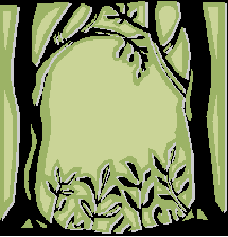EPYPHITES AS BIOINDICATORS
 1.
1.
|
Epiphytes and orchids are well suited to be
indicators of the health and biodiversity of the rainforest, not only because
they are an important source of nutrients for other flora and fauna, but
because they are very sensitive to shifts in microclimate and they have slow
growth. The performance, survival, and distribution of epiphytes is dependent
on stand density, microclimate, distance from seed source, tree size and
species, type and history of disturbance, population dynamics of epiphytes
and trees, and epiphyte physiology (Hietz 1999).
|
Epiphytes are far more vulnerable to deforestation than other flora. For
example, 26% of vascular plant species present in 1900 is now extinct, but
62% of epiphyte species are extinct. Epiphytes are completely dependent on
their host plants, so if a tree is cut down, all of the epiphytes residing
on that tree will die. In addition, they have very specific zoning constraints,
so secondary vegetation might not have all of the necessary micro sites for
different epiphyte species.
Table 1 (Hietz 1999) illustrates the loss of species and biodiversity
in a plantation as compared with old growth forest. While the number of
species for the two groups is not very different, there is considerable
loss of biodiversity, because only epiphytes residing in some of the locations
on a tree are present.
TABLE 1. Epiphyte Richness and Occurrence of Ecological Groups in an Old
growth Forest and an Alnus Plantation.
Figures in parentheses for the plantation are fertile species, all
species in the old growth forest were found with fertile individuals.
|
Epiphytic Species Living on:
|
Oldgrowth
|
Plantation
|
stem base
|
9
|
0 (0)
|
stem and thick branches
|
14
|
7 (3)
|
thick and thin branches
|
11
|
11 (7)
|
preference unclear
|
5
|
3 (1)
|
total
|
39
|
21 (11)
|
In addition to complete deforestation, epiphytes are
hurt by fragmentation. Their wellbeing depends on the distance from their
fragment to closed forest, and the shape of the fragment (this affect seed
dispersal).
They are also affected more adversely by increased CO2 levels in the atmosphere.
Raised CO2 levels shift climate zones, forcing flora and fauna to migrate.
Although epiphytes could migrate more easily than trees, many models of the
effect of fluctuating CO2 levels predict increased seasonality of precipitation,
and thus a reduction of the perhumid area containing the highest epiphyte
diversity (Hietz 1999).
Specific species or groups have been identified as good bioindicators.
- the hemiepiphytic Ficus is a keystone species because of its "numerical
abundance, intra-crown synchrony of fruit ripening, relatively short intervals
between fruiting, large crop sizes and intrapopulation fruiting asynchrony"
and the fact that it is often available as a food source for birds when other
fruits are scarce (Lambert and Marshall 1991).
- Lichens are often used as an indicator of air quality: Tillandsia,
for example, is particularly sensitive to lead pollution.
Epiphyte N concentration:
Epiphytes obtain their Nitrogen either from canopy soil
or from nutrients in rainwater. Nitrogen-15 concentration is much higher
in ground-rooted plants than in epiphytes with access to canopy soil, pointing
to a much richer source of Nitrogen in terrestrial soil versus canopy soil.
In addition, N-15 concentration is much higher for those epiphytes in canopy
soil than those on smaller branches, indicating that epiphytes on smaller
branches have to rely almost exclusively on rainwater as a source of Nitrogen.
This means that these epiphytes (on small branches) are much more susceptible
to drought and thus would be better bioindicators.
Next: Effects of fragmentation on epiphytes
References:
Hietz, Peter. "Diversity and Conservation of Epiphytes
in a Changing Environment." International Union of Pure and Applied
Chemistry (IUPAC).
1998.
Volume 70: Issue 11. Available at:
http://www.iupac.org/symposia/proceedings/phuket97/hietz.html
Turner, T.H.; Tan, H.T. W.; Wee, Y.C.; Ibrahim, Ali
Bin; Chew, P.T.; Corlett, R.T. "A Study of Plant Species Extinction
in Singapore: Lessons for the
Conservation of
Tropical Biodiversity." Conservation Biology. September 1994.
Volume 8: Issue3, pgs. 705-12.
Lambert, Frank R. and Marshall, Adrian G. "Keystone characteristics of Bird-
dispersed Ficus in a Malaysian lowland Rain Forest." Journal of Ecology.
1991. Volume 79, pgs. 793-809.
Hietz, Peter; Wanck, Wolfgang; Wania, Rita; Nadkarni, Nalim M. "Nitrogen-15
natural abundance in a montane cloud forest canopy as an indicator of
nitrogen cycling and epiphyte nutrition." Oecologia.
2002. Volume 131, pgs. 350-355.
Pictures:
1. Picture from: http://www.friendsoffakahatchee.org/images/




